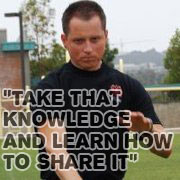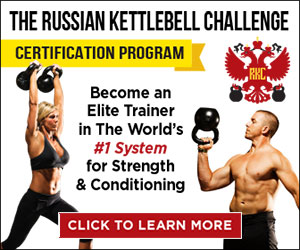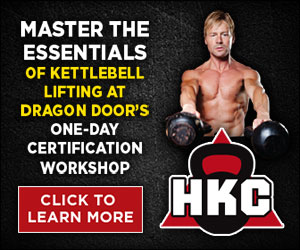Adrienne:
I am here today with Franz Snideman, Senior RKC, who was kind enough to take the time to answer a few questions. Franz, how did you first discover kettlebells?
Franz:
I first discovered kettlebells through my identical twin brother, named Keats Snideman. He’s an RKC from Arizona. I have always been into progressive new stuff in fitness, and in 2002, my brother said, “You’ve got to try these things called kettlebells. They’re amazing.” I bought a couple. I was horrible at them. I had no idea how to use them, and then in the fall of 2002, my clients and I found Pavel and we said, “This is the guy that we need to go learn from,” so we hired him. We drove up to Santa Monica for a two hour private session with him at the Santa Monica beach. It literally changed the entire course of my career. Pavel told me about his RKC certification, which was then probably only in its second year. I think it started in ’01, maybe the end of 2000, so it was fairly new. I took it in April of ’03 and the rest is history.
I’ve been doing predominantly kettlebells for eight years, going on nine years. That’s how I got started. It was just through an introduction from my brother. 
Adrienne:
What is your favorite thing about training with kettlebells?
Franz:
I think it’s the versatility of the actual tool. Even though it does have a pretty steep learning curve in the beginning, the fact that you can learn the Olympic-type style of lifting without having to go through a lot of challenges that you have with barbells. I don’t know if you’ve tried any of the Olympic barbell lifts, which I love, I think Olympic lifting is amazing, but I found for me and some my orthopedic challenges that kettlebells were a much better fit for my body. I was able to get a lot of the benefits from a power standpoint, learning to move my body very quickly and explosively, but without all the technical ramifications that come with Olympic barbell lifting. For me, it was just a natural fit. I have a rule when I teach, I don’t teach things that I can’t do, so I don’t teach Olympic lift with barbells ‘cause I suck at Olympic lift with barbells. I can get the same benefit not only with myself but with my clients in teaching them snatches, clean and jerks etc. You can do similar movements with kettlebells, it’s just easier to teach them – it’s not simple, but it is a little easier to teach them with kettlebells. I like the ability to take the kettlebell and to adapt it to any type of person, which I don’t think every person is qualified to put a barbell overhead, just as some people can’t put a kettlebell overhead. It’s an incredible, versatile tool that anybody could use.
Adrienne:
Normally with the Olympic lifts, there seems to be a big intimidation factor with just even the size of the barbell involved, and then finding the facilities to practice the lifts safely. The great thing about the kettlebell is that you can just put it in the car, and the world becomes your gym – the local park, the beach, backyard wherever.
You gave a really good talk at the Orlando RKC weekend about what the RKC certification is and what it means. I was curious on a personal level about what your RKC certification means to you.
Franz:
For me it’s multifaceted. On a personal level, it gives me a greater domain to learn from others, because I found that some of the smartest people that I’ve met in my life, when it comes to strength training and health, have been inside this RKC community. I think of it as this evolving think tank which has very high standards. I tend to do better when

I’m around people that are really progressive, people who are always learning, hungry to learn and just very willing to share. For me, the RKC is an evolving think tank that has made me better and continues to make me better. It also gives me a kind of a conceptual framework, a roadmap, for my own training and also for my clients’ training. More than anything, it’s given me exposure to very cutting edge strength training principles that absolutely work, and which are simple. They’re not easy, but they’re simple. The RKC has really taken a lot of the clutter and nonsense that is in the fitness industry and has cleaned the slate. The RKC is saying at the end of the day, there’s a couple of key principles that you need to learn if you want to get really strong and really fit. And if you have any athletic ambition, this is really what you need to learn. It’s given me a framework with these incredible principles. I know they work because I’m able to do things that I’ve never been able to do before, and my clients are able to do things that they wouldn’t have dreamed of doing. The proof is in the pudding. This system does work, and it is one that you can expand and grow and continue to evolve with. So I think that’s what the RKC number one is to me, and number two, it’s just an amazing community. You just meet incredible people, like yourself, and you have this common bond with now thousands of RKCs all over the world pushing this movement of the kettlebell. And not just the kettlebell, a system of body mechanics and learning to move in a different way. When you’ve got thousands of minds collectively improving it, that’s pretty special. We have the forums, we can talk, we can share ideas. I haven’t really found that in too many other systems. The RKC is my home base. It’s not that I don’t open up my mind to other things, but it is an incredible system. You have to be on the inside and really apply it to have these kind of opinions. Obviously you’re an RKC, so you’ve kind of swallowed the Kool-Aid, you understand this is how it works.
Adrienne:
It’s also the shared experience, having gone through the RKC certification process is something that really cements the idea of community. Speaking of community, you and your wife, Yoana own Revolution Fitness and are now Dragon Door distributors?
Franz:
We’re the exclusive Dragon Door Kettlebell distributor for San Diego County. So if people want to get kettlebells and save on shipping, we actually get a lot of RKCs and a lot of non-kettlebell instructors as well come by. We sell kettlebells all the time – it’s a product I really believe in. I think Dragon Door makes the best kettlebells out there. You pay a little bit more for them, but you’re paying for quality and you pay for what you get, and they’re the best.
Adrienne:
I have some kettlebells that are from Dragon Door and some that aren’t and I can really tell when I have to use ones that aren’t.
Franz:
Yeah, it definitely makes a difference. I think if you’ve never used a kettlebell, you wouldn’t know. You wouldn’t know any difference. But once you’ve used the Dragon Door Kettlebells… the finish is better, the handle is better. They’re just a better fit for the body. They just feel better. But again, you’d have to try it to know. You wouldn’t know unless you’ve tried many types of bells.
Adrienne:
So what’s in store for the future with Revolution Fitness?
Franz::
We’re going continue to grow our business. That’s why we are in business, to grow, expand, and to be able to influence more people. We have another DVD that is coming out hopefully this spring. It’s the second volume of our work-along DVD. Our first one was called the Quick Results Kettlebell DVD, which is sold by Dragon Door. It’s a follow along DVD with nine different sets of timed workouts. That’s been a very good seller, and a very popular product. Now we’re coming out a second phase of that, and it’s going to be harder, more advanced, more torturous – in a good way. My wife, Yoana, is finishing a kettlebell exercise training manual, a kind of workbook for women that are planning on getting pregnant or for trainers that might be training women that are pregnant. It’s kind of an evolving project that’s been in the works, but that should hopefully be out by spring as well. As of now, those are the main projects on the horizon. On a personal level, I’m trying to get back into my sprinting. I took last year off completely. We had a son and I didn’t get a get a lot of time to exercise or to sprint, but I have a couple of meets coming up in the 100 meter dash, so that should be fun.
Adrienne:
On the Dragon Door forums, people sometimes talk about the “What the Hell” effect, where kettlebell training causes a dramatic positive change with the performance of a seemingly unrelated sport or skill. Has it effected your sprinting performance?
Franz:
I don’t know, per se, ‘cause I really haven’t given sprinting the honest kind of job that it needs. If you don’t really sprint, it’s kind of hard to tell. But I feel that I’ve been able to maintain, as I’ve gotten older, some of the quickness and agility that I had when I was in my 20s, when I was probably running much, much faster times. But I will say that, I’ve never been a distance runner, and anything over a mile for me is distance. So recently I’ve been wanting to get outside a little bit more, I’ve added about two or three days of, like, 20 to 30 minute runs. That’s a couple miles, maybe two or three miles, and without doing any running for years, it hasn’t been a problem. ,I obviously didn’t get fit from running, I don’t run, I sprint, and that’s a totally different ballgame. I would say that the “what the hell” effect of years of kettlebell training has allowed me to go into running, and it’s not that hard for me. It feels fine, I don’t feel like I’m exhausted. It’s nice to know that without having to actually run, if you do snatches, lots of swings, your running can improve. I think there’s lots of people that have experienced what I’m talking about. I can go out and run and I might not win a marathon or anything, but, I can definitely run a pretty good pace and I’m fine. I would say that is a pretty cool bonus to the kettlebells, for sure.
Adrienne:
What is your favorite way to introduce the kettlebell to someone who is a complete beginner, that have absolutely no idea what to do with it. How do you introduce the swing to someone who has never touched a kettlebell?
Franz:
Well, a lot of the people that are coming to see me kind of already know that I use kettlebells. The ones that don’t, I explain to them that it’s not really about the kettlebells, and I teach them about the movements. I teach the movement aspect first. For example, on the dead lift, I’ll put a pole on somebody’s back and head to demonstrate the movement, teaching the level one movements: how to hinge from the hips, how to keep a neutral spine. For the most part, I stick with the basics from the RKC level one, because they work. Occasionally I will venture off into some other areas, but I find that level one tools are so effective that you really don’t need to. You don’t need to invent a bunch of stuff. Thousands of people have collectively found that this stuff has worked. I start with the ground-based movements, teaching people to bend from their hips, to hold a neutral spine. If that doesn’t work, put them in a kneeling position, see if they can bend in a kneeling position. Break down the movement enough to where they can learn something valuable and actually have something neurologically change in their brain.
For me, it’s about getting people to learn to be comfortable in the positions. I say it’s not about the kettlebell. First and foremost I like to teach the postures and the positions, because if you can’t really hold the posture statically, your body can’t really get in there, it’s probably not going to magically happen if I strap a kettlebell to them. It’s just not gonna happen. When you can get into those positions and postures, then we’ll talk about swinging the weight and breathing and all that. The get up is the same. For a lot of people, the get up just absolutely fixes them, for others it’s a little advanced and you really have to break it down.
For the most part, I think the get up and swing are an excellent start, but I don’t always do that. Sometimes I’ll get people squatting, we’ll do box squats, I might even break it up with halos or we’ll do some pump stretches on the floor. The goal for me with kettlebells is to get people in an athletic standing position, teach them to move their hips and teach them to move athletically. Which, if you follow the RKC principles, is actually not that hard, if you’re patient with people.
Adrienne:
You mentioned sprinting earlier, what other training modalities do you practice personally?
Franz:
Recently I’ve gotten into Indian Clubs, not that it’s gonna replace the kettlebell, because it’s it’s not that type of tool. But I would say that I’ve been exposed to a lot of different tools and I probably still use quite a bit of tools. I use sandbags, I have a big, giant tire that I use. I love ropes, like the Battling Ropes. I’ve been using those for years. I think John Brookfield’s a genius, the guy who came up with that entire concept. I absolutely love ropes. I think it’s such a unique way to train. I love body weight exercises, gymnastics type of exercises. I’m a fan of movement. I like a lot of the ashtanga yoga stuff that I see, I like tai chi, I like a lot of the martial arts. I don’t have a background in martial arts, but the older I get, the more I respect those kind of ancient, authentic movement systems.
But I think for me personally, it really comes down to basically just I think kettlebells, a barbell for dead lifting and squatting, sprinting, and I’m beginning to do some handstand stuff. I think with those tools you can get into really, really good shape, and you can also learn a lot. You can really learn a lot about how to move if you use the tools correctly. I’m not against most tools. I just think the older you get and the more you’ve been in the fitness industry and I’ve been in this industry for 14 years now full time, you get to a point where you’re just not wanting to add more stuff. There’s a lot of good stuff out there, but if your goal is to get from point A to point B, usually the fastest way to get there is a straight line. If I zig zag all around, I can get kind of lost. In the beginning, I had a tendency to get overstimulated. I was addicted to the stimulation of new tools, and I think it can be a hindrance. For a lot of people it keeps them from really getting stronger, which is, again, why I like the RKC system. It gives you a framework in how to actually objectively see if you’re getting better at something. Kettlebell swings, for example, or can you clean and press a heavier weight? Can you do a pull up with a 24 kilo if you’re a girl or a Beast if you’re a guy? Its good to be exposed to a lot of tools, but have a couple that you are really comfortable with.
I would rather have a coach say ”I know how to use a lot of different tools, but I have two or three tools that I really use because I can get people better, I have results in getting people better, and I have a lot of history that this actually works.” I would rather be with a coach that is really good at a couple of things, rather than a coach that is kind of good at a million different things. That I think is a trap, and again, we shouldn’t keep our minds shut, but we should also kind of say, all right, is this really gonna help me? At the end of the day, only you can answer that question, but for me it’s just keeping things a little bit more simple. I love a lot of tools, but I think the ones we talked about are tried and they work.
Adrienne:
Makes sense, especially with moving towards mastery with a few tools instead of mediocrity with a whole lot of things. You’re an RKC Team Leader (Franz Snideman has recently been promoted to Senior RKC), do you have any advice for someone who may want to become one one day?
Franz:
I think you have to be very active in the Dragon Door community. It’s Pavel’s certification and he sees qualities in instructors that allow him to choose people to become team leaders or seniors or masters. I agree with a statement that Master RKC Mark Reifkind said a couple years ago at the San Diego RKC certification. (In fact, it was the first certification we ever had in San Diego.) Somebody asked that question, they said, “Mark, how do you become a master? How do you become a senior?” And Mark said, “You know what? You don’t become one. You already are one.” If you’re a team leader, you already are a team leader, we just haven’t found you yet, but we’ll find you. Because you can’t really fake it. If you’re not passionate about it, you won’t stick around in this community. If you’re not passionate about it, you won’t really get good. You won’t be able to really communicate with people about it, because it’s an inside job.
If you are a team leader, you already are one, you’re maybe not there yet, but you will be. That’s my approach, I tell instructors that really have an ambition to reach that level and say, “If you really think that you already are one, you probably are and you know it.” Be humble about it, but, you know, do as much as you can for yourself. Become as educated and as knowledgeable in this field as possible. That’s probably number one. Two is take that knowledge and learn how to share it. 
Go to seminars, assist. If you have an HKC workshop around, ask if you can help. If there’s an RKC certification in your area, assist. If Pavel is doing a workshop or Andrea DuCane goes to your state and does a workshop, get involved. I’m just using you as an example, it could be somebody anywhere. It is an honor to be a team leader and to be in a position of leadership, because the guys at the top are absolutely the real deal, they are honestly, genuinely, and authentically into this stuff. You either have it or you don’t, and the people that aren’t really into it won’t stick around, and that’s fine. Not everybody has ambition to do this as a career. We get doctors, you get lawyers, you get people that love kettlebells that don’t necessarily want to become a Master RKC. But there are some people who know without a doubt that this is a career path that they want to do. They want to be a coach, to teach, to help people, and to make a nice living doing it, which is very healthy and normal.
That’s the path I’ve chosen. I chose that path back in 1996 and said “I love this, I don’t want to sit behind a desk and work for somebody else, this is what I want to do. What do I need to do to get better at this? I want to coach people, I want to make a difference in people’s lives, and I want to get up every day, be pretty jazzed about going to work.” When you work for yourself and this is your passion, it’s not a chore, like” Oh God, I’ve got to go to work, I’ve got to teach a kettlebells.” No, you enjoy it, you love it. If you’re genuinely, passionately in love with this field, those are the people that I usually recommend. If that’s you and you have a teachable spirit and you’re willing to go through some tough times to learn how to work on your weaknesses, then I say absolutely, this is the field for you. Then maybe this this collective Dragon Door RKC community might be the framework for you to launch yourself. It’s definitely been a launching pad for me on a professional and personal level, so I would encourage everybody. If you like this and you realize what an awesome system we have, get involved, help, come on into the conversation, jump in.
Adrienne:
Off the top of your head, do you have a favorite workout with kettlebells?
Franz:







Leave a Reply